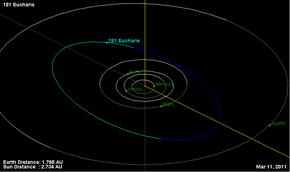 Orbital diagram Orbital diagram | |
| Discovery | |
|---|---|
| Discovered by | Pablo Cottenot |
| Discovery date | 2 February 1878 |
| Designations | |
| MPC designation | (181) Eucharis |
| Pronunciation | /ˈjuːkərɪs/ |
| Named after | Eucharis |
| Alternative designations | A878 CB; 1906 GA |
| Minor planet category | Main belt |
| Orbital characteristics | |
| Epoch 31 July 2016 (JD 2457600.5) | |
| Uncertainty parameter 0 | |
| Observation arc | 123.63 yr (45157 d) |
| Aphelion | 3.7664 AU (563.45 Gm) |
| Perihelion | 2.49280 AU (372.918 Gm) |
| Semi-major axis | 3.12958 AU (468.179 Gm) |
| Eccentricity | 0.20347 |
| Orbital period (sidereal) | 5.54 yr (2022.2 d) |
| Average orbital speed | 16.64 km/s |
| Mean anomaly | 32.3207° |
| Mean motion | 0° 10 40.879 / day |
| Inclination | 18.890° |
| Longitude of ascending node | 143.224° |
| Argument of perihelion | 318.943° |
| Earth MOID | 1.53686 AU (229.911 Gm) |
| Jupiter MOID | 1.47086 AU (220.038 Gm) |
| TJupiter | 3.099 |
| Physical characteristics | |
| Dimensions | 106.66±2.2 km |
| Synodic rotation period | 52.23 h (2.176 d) |
| Geometric albedo | 0.1135±0.005 |
| Spectral type | S (Tholen) Xk (Bus) |
| Absolute magnitude (H) | 7.84 |
181 Eucharis is a large, slowly rotating main-belt asteroid that was discovered by French astronomer Pablo Cottenot on February 2, 1878, from Marseille Observatory. It was his only asteroid discovery. This object was named after Eucharis, a nymph from the 17th-century novel Les Aventures de Télémaque.
In the Tholen classification system, it is categorized as a stony S-type asteroid, while the Bus asteroid taxonomy system lists it as an Xk asteroid. Photometric observations of this asteroid at the Goat Mountain Astronomical Research Station in Rancho Cucamonga, California during 2007 gave a light curve with a leisurely rotation period of 52.23 ± 0.05 hours.
This object is the namesake of a family of 149–778 asteroids that share similar spectral properties and orbital elements; hence they may have arisen from the same collisional event. All members have a relatively high orbital inclination.
References
- "eucharis". Oxford English Dictionary (Online ed.). Oxford University Press. (Subscription or participating institution membership required.)
- ^ Yeomans, Donald K., "181 Eucharis", JPL Small-Body Database Browser, NASA Jet Propulsion Laboratory, retrieved 12 May 2016.
- ^ Stephens, Robert D. (March 2008), "Long Period Asteroids Observed from GMARS and Santana Observatories", The Minor Planet Bulletin, vol. 35, no. 1, pp. 21–22, Bibcode:2008MPBu...35...21S.
- ^ DeMeo, Francesca E.; et al. (July 2009), "An extension of the Bus asteroid taxonomy into the near-infrared" (PDF), Icarus, vol. 202, no. 1, pp. 160–180, Bibcode:2009Icar..202..160D, doi:10.1016/j.icarus.2009.02.005, archived from the original (PDF) on 17 March 2014, retrieved 8 April 2013. See appendix A.
- "Numbered Minor Planets 1–5000", Discovery Circumstances, IAU Minor Planet center, retrieved 7 April 2013.
- Novaković, Bojan; et al. (November 2011), "Families among high-inclination asteroids", Icarus, vol. 216, no. 1, pp. 69–81, arXiv:1108.3740, Bibcode:2011Icar..216...69N, doi:10.1016/j.icarus.2011.08.016.
External links
- 181 Eucharis at AstDyS-2, Asteroids—Dynamic Site
- 181 Eucharis at the JPL Small-Body Database

| Minor planets navigator | |
|---|---|
| Small Solar System bodies | |||||||
|---|---|---|---|---|---|---|---|
| Minor planets |
| ||||||
| Comets | |||||||
| Other | |||||||
This article about an S-type asteroid native to the asteroid belt is a stub. You can help Misplaced Pages by expanding it. |